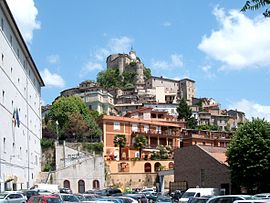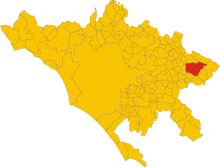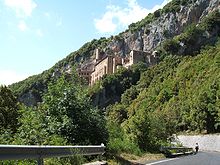Subiaco (Lazio)
| Subiaco | ||
|---|---|---|

|
|
|
| Country | Italy | |
| region | Lazio | |
| Metropolitan city | Rome (RM) | |
| Coordinates | 41 ° 55 ' N , 13 ° 6' E | |
| height | 408 m slm | |
| surface | 63 km² | |
| Residents | 8,800 (Dec. 31, 2019) | |
| Population density | 140 inhabitants / km² | |
| Post Code | 00028 | |
| prefix | 0774 | |
| ISTAT number | 058103 | |
| Popular name | Sublacensi | |
| Patron saint | Benedict of Nursia | |
| Website | Subiaco | |
 Subiaco, abbots' castle |
||
Subiaco is an Italian commune in the metropolitan city of Rome in the Lazio region with 8800 inhabitants (as of December 31, 2019). The municipality is one of the most historically significant places in Lazio and is a member of the I borghi più belli d'Italia association (The Most Beautiful Places in Italy).
geography
Subiaco is located 70 km east of Rome and 82 km southwest of L'Aquila . It is in the valley of the Aniene .
The old town is grouped at the foot of the castle around a hill at the exit of the Anien Gorge. The municipality extends from 339 to 1778 m slm. The municipality includes the districts Madonna della Pace and Vignola. Subiaco is a member of the Comunità Montana Valle dell'Aniene .
The community is located in earthquake zone 2 (medium risk).
The neighboring municipalities clockwise: Agosta , Cervara di Roma , Camerata Nuova , Vallepietra , Jenne , Arcinazzo Romano , Affile , Rocca Santo Stefano and Canterano .
traffic
![]() The nearest motorway exit is Vicovaro-Mandela on the A24 Autostrada dei Parchi , 25 km away.
The nearest motorway exit is Vicovaro-Mandela on the A24 Autostrada dei Parchi , 25 km away.
![]() The municipality of Subiaco is crossed by the strada statale Sublacense (SS 411) , which runs from Arsoli to Frosinone .
The municipality of Subiaco is crossed by the strada statale Sublacense (SS 411) , which runs from Arsoli to Frosinone .
By 1933 the branch line that ran from Mandela - Sambuci station through the Anienetal ended in Subiaco . Today the nearest train station is in Arsoli on the Rome – Sulmona railway line . However, public buses operated by the Cotral company go to Vicovaro station on the same route. There are other Cotral connections to Tivoli, Frosinone and Rome ( Ponte Mammolo metro station ).
history
Emperor Claudius had three reservoirs built above what is now the city in order to improve the quality of the water that the Anio Novus aqueduct transported to Rome. The lakes served as settling basins for sediments. Only his successor, Emperor Nero , recognized its value as a residential area and had a spacious villa built on one of the lakes. Other patrician families from Rome quickly followed his example. A little further down the river, a village for servants and slaves with the name Sublaqueum (= under the lakes), the predecessor of today's city, was built.
Two of the dams broke in the 12th century. In any case, since then only one lake has been mentioned in chronicles. The third wall was destroyed in 1305 . The tidal wave probably also destroyed the Nero villa, the remains of which were excavated on the outskirts.
Around the year 500, the young Benedict of Nursia decided to move as a hermit into a cave above the Nerovilla, which he only left after three years at the encouragement of his sister, the Holy Scholastica . After a time in the monastery in Vicovaro , he founded the monastery of S. Clemente in a building of the Nero villa, certainly with the support of the then (now unknown) owner. The villas were still in use at that time. Since he had a large influx of new followers, the founding of 12 more monasteries in the Anienetal followed in a short time. Of these, only the Santa Scolastica monastery remains today .
Legend has it that the priest Florentius (probably from Subiaco) forged intrigues out of envy and resentment against Benedict. For example, he allegedly sent 13 naked virgins on the necks of the monks to tempt them. In reality there was arguably a conflict with the Bishop of Tivoli, who was a thorn in the side of the growing influence of Benedict. In 529 Benedict drew the conclusions and went with some loyal followers to the Montecassino , on which he founded today's mother monastery of the Benedictines.
The monastic life of the Benedictines in the valley of Subiaco never died out, even if the monks had to flee to Rome several times in the 9th century from the Saracens . However, monastery life was increasingly concentrated on S. Scolastica. From around 1200, the second monastery of San Benedetto, which is preserved today, was built above the cave (Sacro Speco) of the hermit Benedict .
Through donations, S. Scolastica acquired a large territorial property that extended over the entire upper Anienetal and with a number of castles z. B. was secured in Arsoli and Cervara. The 13th and 14th centuries represented the heyday of the abbey. However, at the expense of the rural population, who were oppressed and exploited more brutally than in all the surrounding dominions.
During this time, Subiaco played the same role as it did during the Roman Empire. Craftsmen and servants who worked for the monastery lived there. A castle was built on the top of the mountain cone around which the city extends, which served as a residence for some abbots.
In November 1454 the situation escalated when young people from the village harassed two monks. That night the abbot sent his mercenaries to Subiaco, who brought 15 young men to the gallows by morning. This led to the popular uprising and the devastation of the abbey.
Pope Calixtus III. took the event as an opportunity to convert the abbey into a cardinal coming, that is, the abbots were no longer elected by the monks, but were cardinals from abroad who were appointed by the Pope. The first Cardinal Abbot Giovanni Torquemada founded the first printing house in Italy in Subiaco.
In 1467, the notorious Rodrigo Borgia , later Pope Alexander VI. , Cardinal abbot and resided in the castle of Subiaco, which he built for himself. The Borgia bull coat of arms has been emblazoned on the castle ever since. In the period that followed, all the important noble families in Rome competed for the lucrative post of Cardinal Abbot of Subiaco. The exploitation of the rural population continued and Subiaco was one of the most backward areas of Italy.
Pope Benedict XIV abolished all secular power and benefices of the oldest Benedictine abbey, which since then has only had purely spiritual significance.
Attractions

- Excavations of the Villa Neros on the road to the monasteries, visits on request
- Santa Scolastica Monastery , the main Benedictine monastery in Subiaco since the 10th century; important library; three cloisters from the 13th, 14th and 16th centuries; St. Scholastica Cathedral , the monastery was badly damaged in World War II, the facade was then rebuilt in a sober style.
- Monastery of San Benedetto or Sacro Speco was built from the 12th to the 14th centuries over the hermit's cave of Saint Benedict and clings to a rock wall like a swallow's nest. The walls of the upper and lower church and the adjoining chapels are complete with significant frescoes from the 12th to 17th centuries. Century painted.
- Rocca Abbaziale , abbots' fortress from the 11th century. Current figure from the 15th century, Rodrigo Borgia.
- Church of San Francesco (from 1327) with beautiful renaissance furnishings
- Ponte di San Francesco (1358), bridge on the road to Arsoli
Population development
| year | 1871 | 1901 | 1921 | 1936 | 1951 | 1971 | 1991 | 2001 |
|---|---|---|---|---|---|---|---|---|
| Residents | 7,525 | 8.003 | 9,348 | 9,053 | 9,178 | 8,431 | 9.004 | 9,030 |
Source: ISTAT
politics
Francesco Pelliccia (Lista Civica: Insieme Per Subiaco) was elected on 14./15. Elected Mayor in May 2011. He replaced Pierluigi Angelucci, who was no longer running; he has served for the second time since the election on June 5, 2016.
coat of arms
The ancient Latin name of Subiaco is Sublacum or Sublaqueum , which means "under the lakes". The coat of arms goes back to this. There are three lakes on a striped sign. Underneath a tape with the inscription "SUB LACUM".
Town twinning
sons and daughters of the town
- Cesare Borgia (1475 / 76–1507), son of Pope Alexander VI. , Duke of Valentinois and role model for The Prince ; possibly he was born here
- Lucrezia Borgia (1480–1519), daughter of Pope Alexander VI, Duchess of Ferrara; According to some sources, he was born in Subiaco Castle
- Antonio Benedetto Antonucci (1798–1879), cardinal of the Catholic Church
- Carmine Gori-Merosi (1810–1886), cardinal of the Catholic Church
- Gina Lollobrigida (* 1927), actress
- Pier Paolo Capponi (1938-2018), actor
- Benedetto Tuzia (* 1944), Bishop of Orvieto-Todi
- Francesco Graziani (* 1952), soccer player and soccer coach
- Valerio Checchi (* 1980), cross-country skier
Web links and sources
- Subiaco on www.comuni-italiani.it (Italian)
- Report by Ferdinand Gregorovius
- Benedictines in Subiaco
- Visit to the monastery of San Benedetto (German)
- Simbruina Stagna (Italian)
- Comunità Montana Valle dell'Aniene (Italian)
Individual evidence
- ↑ Statistiche demografiche ISTAT. Monthly population statistics of the Istituto Nazionale di Statistica , as of December 31 of 2019.
- ^ I borghi più belli d'Italia. Borghipiubelliditalia.it, accessed August 31, 2017 (Italian).
- ^ Italian civil defense
- ^ Information from the Ministry of the Interior , accessed on July 13, 2012



